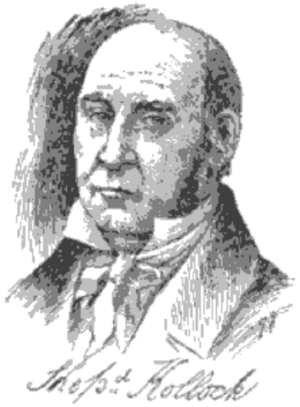Shepard Kollock facts for kids
Quick facts for kids
Shepard Kollock
|
|
|---|---|
 |
|
| Personal details | |
| Born | September 1750 Lewes, Delaware |
| Died | July 28, 1839 (aged 88) Philadelphia, Pennsylvania |
| Resting place | First Presbyterian Church of Elizabeth |
| Spouse |
Susan Arnett
(m. 1777) |
| Children | 12 |
| Occupation | Editor, printer |
Shepard Kollock, Jr. (born September 1750 – died July 28, 1839) was an important editor and printer during the American Revolutionary War. He lived in colonial New Jersey and helped spread news and ideas. After the war, he also worked in different government jobs in New Jersey.
Kollock started the New Jersey Journal newspaper in 1779. This was the third newspaper ever published in New Jersey. He set up his printing press in Chatham, New Jersey, a village settled in 1710. His newspaper, which later became the Elizabeth Daily Journal, was very important. It helped people support the Revolutionary War and shared vital information about the fight for independence.
Amazingly, his newspaper kept publishing for 212 years! It finally stopped on January 3, 1992.
Contents
Shepard Kollock: A Revolutionary Printer
Early Life and Family
Shepard Kollock Jr. was born in September 1750 in Lewes, Delaware. His parents were Mary Goddard and Shepard Kollock. He passed away on July 28, 1839, in Philadelphia, Pennsylvania.
On June 5, 1777, Shepard married Susan Arnett. Susan was the daughter of Hannah White and Isaac Arnett. Shepard and Susan had a large family with twelve children. Shepard Kollock is buried at the First Presbyterian Church of Elizabeth.
Learning the Printing Trade
When he was young, Shepard Kollock went to Philadelphia to learn how to print. He trained with William Goddard, who was the editor of the Pennsylvania Chronicle newspaper. Shepard stayed in Philadelphia until he was twenty years old.
Later, because he wasn't feeling well, he traveled to Saint Christopher in the West Indies. There, he continued his printing business.
Fighting for Freedom
When Shepard heard about the first battles of the American Revolution, like the Battles of Lexington and Concord, he quickly returned to New Jersey. He joined the fight for independence. He became a Second Lieutenant in a group called the Flying Camp in New Jersey. In January 1777, he was promoted to First Lieutenant in the Continental Artillery Regiment. He fought in several important battles, including Trenton, Fort Lee, and Short Hills.
In 1779, he left the army. The Continental Congress, which was the government of the new United States, asked him to start a newspaper. They wanted him to help spread news about the war. So, he established the New Jersey Journal in Chatham. This newspaper was the third one ever published in New Jersey.
The New Jersey Journal: A Voice for Revolution
Shepard Kollock's New Jersey Journal became a very important tool for the revolution. News came directly to him from George Washington's headquarters in nearby Morristown. His newspaper helped to keep the spirits high for both the soldiers and their families. He also printed lively discussions about independence, including ideas from people who supported the cause and those who didn't.
After the British left New York in 1783, Shepard moved his printing press there. He started a new paper called the New York Gazetteer. It was published weekly at first, then three times a week. He also started a newspaper in New Brunswick, New Jersey.
In 1787, he moved his printing business one last time to Elizabethtown. He changed the name of his original newspaper to include the new town's name. He owned and edited the Elizabeth Daily Journal until 1818, when he sold his business. While he was in charge, the newspaper supported presidents like Thomas Jefferson, James Madison, and James Monroe. The Elizabeth Daily Journal stopped publishing on January 3, 1992. It had been running for 212 years! At that time, it was the fourth oldest continuously published newspaper in the United States and the oldest in New Jersey.
Public Service and Later Life
Shepard Kollock also held many important public jobs. By 1808, he was publishing official government documents for the New Jersey Legislative Council.
He served as a judge for the New Jersey Court of Common Pleas for thirty-five years. He also held many important government positions in Elizabethtown, including being an alderman (a local government official). He was even appointed as an aide-de-camp (a personal assistant) to New Jersey Governor Joseph Bloomfield, and then again by the next governor, Aaron Ogden.
After selling his printing business, President Monroe appointed him as the Postmaster of Elizabethtown. He held this job until he retired in 1829. Shepard Kollock was also an original member of The Society of the Cincinnati, a group formed in 1783 for officers who served in the Revolutionary War.
Shepard Kollock also published several books from his press in Chatham. These included:
- The United States Almanack, for the Year of our Lord 1780 (published in 1779)
- The New-England Primer Improved, for the more easy attaining the true Reading of English, To which is added, the Assembly of Divines, and Mr. Cotton's Catechism (published in 1782)
- Ebenezer Elmer, Surgeon of the Regiment, An e[u]logy on the late Francis Barber, Esq: Lieutenant Colonel Commandant of the Second New-Jersey Regiment (published in 1783)
Today, there is a park named after him in Chatham, New Jersey. It's called Shepard Kollock Park and is a place for recreation, located near the Passaic River.

